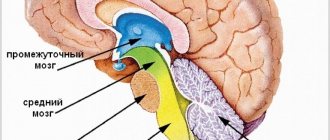Vegetative-vascular dystonia is a disease that affects the nervous and vascular systems of the body. In many cases, the disease does not constantly manifest itself, but its periodic attacks bring discomfort to life due to severe symptoms.
There are no universal drugs to get rid of the pathology, but an effective treatment method is known, which was developed by doctor Andrei Kurpatov - “Remedy for VSD”. This book by him contains the main rules and recipes for therapy for patients with dystonia.
Where does this disease come from?
The diagnosis of VSD is made by doctors very often:
- In childhood - from 12 to 25%.
- In adults - up to 70%.
Experts associate such high rates with the avalanche-like growth of psycho-emotional stress experienced by members of modern society, both during study, at work, and in the family circle. And the predisposing factors are:
- A burdened hereditary history, which leads to the manifestation of VSD in young children.
- Pathologies affecting the central and peripheral nervous system (brain stem, limbic system, hypothalamus).
- A number of chronic diseases of organs included in the endocrine, cardiovascular and gastrointestinal systems.
- Chronic stress, overstrain and overwork, both physical and emotional.
In most cases, vascular dystonia has the appearance of a somatomorphic disorder. This is a neurosis that manifests itself mainly or exclusively as a disruption of the functioning of one or more internal organs, imitating the symptoms of various chronic diseases.
The pathogenesis of somatomorphic disorder occurs in several stages:
- A powerful experience, stress, combined in time with severe overstrain or even exhaustion of the patient’s psyche.
- “Repression” by the psyche of a traumatic situation that it can no longer cope with.
- The development against this background of a number of neurotic manifestations, from which various internal organs suffer.
Favorable factors for a somatomorphic disorder to affect a person are:
- The original imperfect autonomic regulator.
- A complex of surrounding cultural and social factors.
- Features of the psychological structure (for example, the presence of alexithymia - the inability to verbally express one’s own internal experiences).
Factors that aggravate the situation include hysteria, depression, anxiety, emotional instability, tobacco smoking, excessive consumption of alcoholic beverages, and hypochondria.
Sleep, sports and healthy food are the main protectors of the nervous system
To prevent dystonia from becoming a curse throughout life, it is best to treat it in tender childhood. For minor or rare manifestations, the following conservative but reliable methods will help: - improving your daily routine:
You need to sleep at least 8-10 hours a day, it is advisable to do gymnastics every morning and be in the air for at least 2-3 hours a day.
- playing sports in a playful, “non-standard” mode.
It is a mistake to completely exempt children with VSD syndrome from physical activity.
Such children are recommended general strengthening activities in a health group, skating, cycling, outdoor games, table tennis, and even better - swimming. - adherence to a certain diet.
It is worth limiting the consumption of table salt, fatty meats, sweets, and flour.
It is necessary to increase the intake of potassium and magnesium into the body (buckwheat, oatmeal, soybeans, beans, peas, apricots, rose hips, dried apricots, raisins, carrots, eggplants, onions, lettuce, parsley, nuts). — therapeutic massage and physiotherapy
: electrophoresis, electrosleep, water procedures, in short, everything that stimulates the nervous system.
Any hardening procedures are especially useful, because the nervous system, like our entire body, needs training to function without failure. And only in the most advanced cases, when attacks of dystonia literally poison life or seriously interfere with normal existence, is it worth resorting to drug treatment. Treatment of patients with VSD is determined only by the attending neuropathologist, taking into account the nature of the disease. As a rule, patients are prescribed anti-anxiety, sedatives, antidepressants, as well as general restoratives. Along with drug therapy, psychotherapy
, the purpose of which is to eliminate pathological symptoms. Methods of psychotherapy can be varied - this includes suggestion, hypnosis, persuasion, and the use of group classes. They are determined by a psychotherapist in each specific case. Do not hesitate to consult a doctor with such seemingly insignificant symptoms as headache, increased fatigue and irritability, excessive anxiety, etc. The sooner you start treatment, the easier it will be to cope with such an “invisible” disease as vegetative-vascular dystonia .
Symptoms of VSD
The complex of manifestations of vegetative-vascular dystonia can spread to almost any organs and systems of the human body, both together and separately. The most common syndromes encountered in medical practice are:
- Cystalgia.
- Cardiovascular.
- Hyperventilation.
- Sexual disorders.
- Irritable bowel.
- Thermoregulation disorders.
- Increased sweating.
And now about each of them in more detail
Cardiovascular syndrome
Manifested by lesions of the cardiovascular system. The patient experiences various types of arrhythmias:
- Extrasystole.
- Bradycardia.
- Tachycardia.
Blood pressure indicators may constantly change, vascular tone is also unstable, which is manifested by “hot flashes”, pallor, even “marbling” of the skin, as well as a feeling of chilliness in the hands and feet. Unpleasant sensations in the heart area manifest themselves:
- Discomfort behind the sternum.
- Stitching, aching or throbbing pain.
Pain during VSD is distinguished from angina by the lack of connection with physical activity, as well as the lack of effect from nitroglycerin.
Hyperventilation syndrome
The main manifestations of this syndrome:
- Tachypnea.
- Feeling of lack of air.
- Feeling of difficulty in breathing or incompleteness.
All this leads to the loss of a large amount of carbon dioxide from the blood, with its further alkalization, which has a depressing effect on the respiratory center. The result is muscle spasms, sensitivity disorders in the feet, hands, area around the mouth, and dizziness.
Irritable bowel syndrome
Its manifestations:
- Pain in the lower abdomen, aching and spastic in nature.
- Flatulence.
- Stool disorders.
- Increased urge to defecate.
- Appetite disorder.
- Nausea to the point of vomiting.
- Dysphagia (swallowing disorder).
- Discomfort and pain in the epigastrium.
At the same time, there are no organic changes in the gastrointestinal tract.
Increased sweating
It manifests itself as excessive sweating (hyperhidrosis), which is most often observed on the soles and palms.
Cystalgic syndrome
The patient urinates more frequently and is accompanied by painful sensations. In this case, there are no diseases of the genitourinary system and no changes in the composition of urine are detected.
Sexual disorders
Manifestations of the syndrome include problems with erection and ejaculation in the male part of patients, and, as for women, in them VSD leads to vaginismus coupled with anargasmia. But sexual desire may remain or decrease.
Violation of thermoregulation
Children most often suffer from this syndrome. It manifests itself with chills and low-grade fever. Patients tolerate hyperthermia quite easily; the temperature is higher at the beginning of the day. Sometimes thermometry of the left and right armpits shows different results.
Diagnosis of vegetative-vascular dystonia and its treatment
The most important stage of the examination is the differential diagnosis between VSD and various organic pathologies of the relevant organs or their systems. It is carried out by specialized specialists. The next stage of the examination is performed by a psychoneurologist, whose task is to psychologically study the patient in order to find the causes of the development of autonomic disorders.
The main thing in these conversations is complete trust between the patient and the doctor, a comprehensive story about any unpleasant situations that could become an impetus for the development of pathology, the consequences of which must be gotten rid of.
Patients suffering from vegetative-vascular dystonia go to doctors for a number of years and receive a vague diagnosis of VSD along with assurances that everything is fine. For some, the psyche cannot stand it; they begin to doubt the sobriety of their own mind. Therefore, it is so important to have constant support for a patient with VSD from a neurologist who knows how to get rid of this painful disease, as well as self-education, thanks to which a person will better recognize the pathology that he has encountered and will treat it without unnecessary fear.
Where to look for the causes of vegetative-vascular dystonia?
First, a little dry theory: VSD is a syndrome that includes disorders of autonomic functions of various origins and manifestations, caused by a disorder of their neurogenic regulation. The term “dystonia” reflects the idea of an imbalance in the tone of the sympathetic and parasympathetic systems as a source of autonomic disorders. The reasons for its occurrence are quite diverse: - hereditary and constitutional factors.
In early childhood, hereditary burden, lack of oxygen in the fetus during pregnancy, birth injuries and diseases of infancy are important for the occurrence of VSD.
All these factors may not lead to gross organic brain damage, but lead to minimal peripheral dysfunction of the autonomic system. - psychogenic or psycho-emotional factors:
sudden, unexpected, shocking events or states of prolonged emotional overstrain leading to a nervous breakdown. The psychological atmosphere in the family is of great importance for the development of the disease (as well as for overcoming it). Let’s say, if only your mother was involved in your upbringing as a child, without your father’s active participation, then the risk of ending up in the group of people suffering from dystonia increases. As a rule, when raising a child, women often experience anxiety and doubt their competence, so they often rush to extremes, which can displease the “head of the family.” Subconscious dissatisfaction that arises in a child due to the complexity of the relationship between mother and father often causes him to feel protest, aggression, conflict and is reflected in the reaction of the autonomic system - headaches, emotional instability, short temper, and dizziness appear. Vegetative-vascular dystonia can also develop as a result of previous chronic infections, age-related endocrine changes in the body, intoxication, etc.
Information weapons in the fight against VSD
Several years ago, a book appeared in the public domain, the author of which, Andrei Kurpatov, is a doctor who has been treating autonomic dysfunction for many years. He decided to present his invaluable experience on the pages of a small book. Its target audience is very wide: people who have been exhausted by long-term and unsuccessful treatment for VSD, patients who first discovered the symptoms of this disease and have just begun an endless visit to specialists in search of the cause of their illness, even those people who managed to achieve stable remission. After all, most of those who read this work by Dr. Kurpatov, for the first time in their lives, learn that you can get rid of VSD once and for all.
It contains information about the way to regain lost health and peace of mind, about means that can activate the hitherto hidden resources of the human body that can overcome most of the symptoms of VSD.
What is VSD from the point of view of Dr. Kurpatov
Vegetative neurosis, neurocirculatory dystonia and vegetative-vascular dystonia are diagnosed quite often. All these names are united by one thing - the incomprehensibility of the wording and the fear of the impossibility of being cured of this disease forever.
The book that Kurpatov wrote, “The Remedy for VSD,” will help everyone quickly and easily understand the variety of manifestations of the disease:
- Changes in blood pressure.
- Dizziness when riding in public transport.
- Sweating when in a stressful situation.
- The emergence of fear for no apparent reason.
The author slowly and methodically convinces readers that the main cause of all troubles lies in their own thoughts, in the self-programming of their own organisms for negativity.
Vegetative-vascular dystonia is most often based on three pillars:
- Fear.
- Stress.
- Chronic lack of sleep.
The pathology occurs in the same way for everyone - there is an accumulation of negative factors, gradually leading to problems with well-being:
- Changes in blood pressure.
- Gradually increasing weakness.
- Fatigue in response to even minor physical or mental activity.
The result of this is walking from one doctor's office to another in search of a solution to the problem. Standard examination schemes by therapists, and then by cardiologists and endocrinologists, do not reveal any deviations from the norm. Eventually, patients are diagnosed with VSD and referred to psychologists or psychiatrists. And the next stage begins - training or antidepressants, which bring relief only during the course of treatment, and after its completion all the sensations return again.









